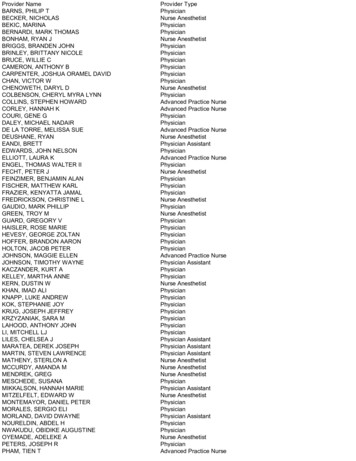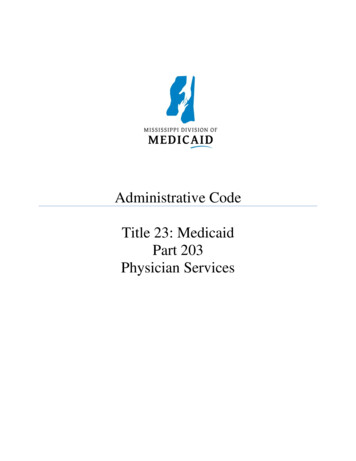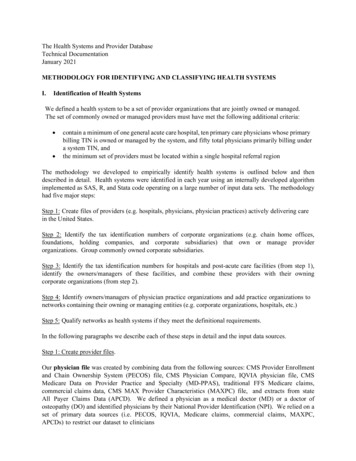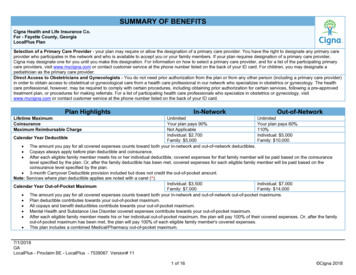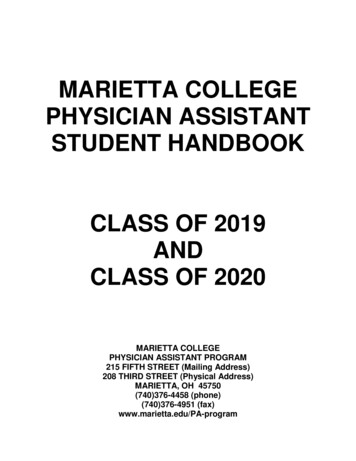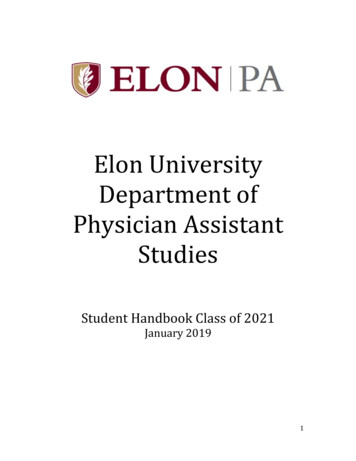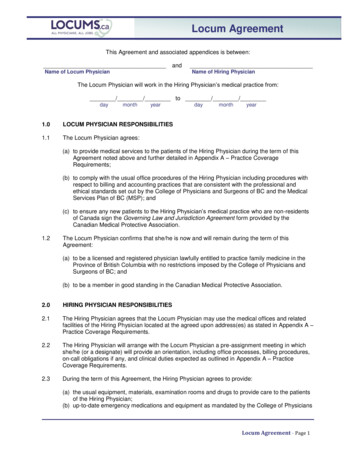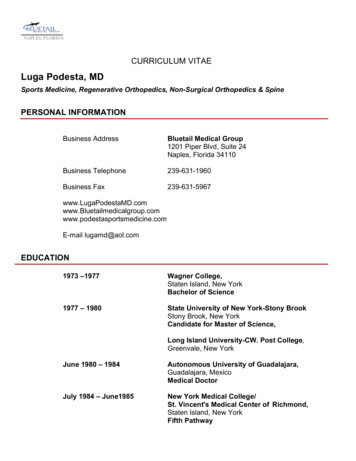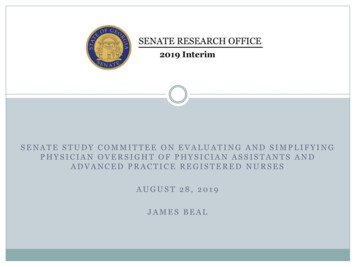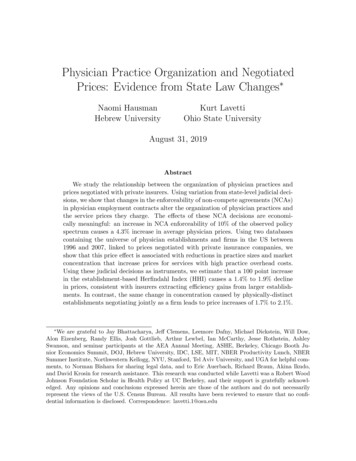
Transcription
Physician Practice Organization and NegotiatedPrices: Evidence from State Law Changes Naomi HausmanHebrew UniversityKurt LavettiOhio State UniversityAugust 31, 2019AbstractWe study the relationship between the organization of physician practices andprices negotiated with private insurers. Using variation from state-level judicial decisions, we show that changes in the enforceability of non-compete agreements (NCAs)in physician employment contracts alter the organization of physician practices andthe service prices they charge. The effects of these NCA decisions are economically meaningful: an increase in NCA enforceability of 10% of the observed policyspectrum causes a 4.3% increase in average physician prices. Using two databasescontaining the universe of physician establishments and firms in the US between1996 and 2007, linked to prices negotiated with private insurance companies, weshow that this price effect is associated with reductions in practice sizes and marketconcentration that increase prices for services with high practice overhead costs.Using these judicial decisions as instruments, we estimate that a 100 point increasein the establishment-based Herfindahl Index (HHI) causes a 1.4% to 1.9% declinein prices, consistent with insurers extracting efficiency gains from larger establishments. In contrast, the same change in concentration caused by physically-distinctestablishments negotiating jointly as a firm leads to price increases of 1.7% to 2.1%. We are grateful to Jay Bhattacharya, Jeff Clemens, Leemore Dafny, Michael Dickstein, Will Dow,Alon Eizenberg, Randy Ellis, Josh Gottlieb, Arthur Lewbel, Ian McCarthy, Jesse Rothstein, AshleySwanson, and seminar participants at the AEA Annual Meeting, ASHE, Berkeley, Chicago Booth Junior Economics Summit, DOJ, Hebrew University, IDC, LSE, MIT, NBER Productivity Lunch, NBERSummer Institute, Northwestern Kellogg, NYU, Stanford, Tel Aviv University, and UGA for helpful comments, to Norman Bishara for sharing legal data, and to Eric Auerbach, Richard Braun, Akina Ikudo,and David Krosin for research assistance. This research was conducted while Lavetti was a Robert WoodJohnson Foundation Scholar in Health Policy at UC Berkeley, and their support is gratefully acknowledged. Any opinions and conclusions expressed herein are those of the authors and do not necessarilyrepresent the views of the U.S. Census Bureau. All results have been reviewed to ensure that no confidential information is disclosed. Correspondence: lavetti.1@osu.edu
1IntroductionAt 17.2% of GDP, the share of income devoted to healthcare in the US is over 90%higher than the OECD average.1 Many studies, including Pauly (1993) and Anderson etal. (2003), have shown that this difference in spending is primarily due to differences inprices rather than quantities, which has led researchers to try to understand why pricesare so much higher in the US. Much of this attention has focused on how competitionaffects prices in health insurance markets (Dafny (2010); Dafny et al. (2012); Ericsonand Starc (2012); Ho and Lee (2016)) and in hospital markets (Gowrisankaran et al.(2014); Gaynor and Vogt (2003)). There is relatively less evidence on the determinantsof physician prices, even though physician services account for a large and rising share(20%) of total U.S. medical spending.2 Previous research has found evidence that pricesof physician services are higher in more concentrated markets, based on across-marketcomparisons of specialist prices (Dunn and Shapiro (2014); Kleiner et al. (2015)), andwithin-market changes in prices over time (Baker et al. (2014)).This paper provides new evidence on the impacts of physician practice organizationand market concentration on prices negotiated with private insurers. We quantify theextent to which organizational changes at the establishment and firm levels may havedifferent effects on prices.3 These differences could occur, for example, due to the importance of efficiency gains relative to improvements in bargaining position when physicianpractice growth occurs within versus across locations. To provide evidence on these organizational dynamics, our research design builds upon and extends previous studies intwo primary ways.First, we develop the most comprehensive known database to date on physician practices and negotiated prices, including two complete censuses of practices in all specialtiesand geographic markets in the US between 1996-2007. The Medicare Physician Identification and Eligibility Registry (MPIER) from the Center for Medicare and MedicaidServices (CMS), which contains all practicing physicians in the US, allows us to aggregate physicians by practice location and measure establishment sizes by specialty andgeography. In addition, we use confidential Census Bureau data from the LongitudinalBusiness Database (LBD), Economic Censuses (EC), and Business Register (SSEL) toobserve firm-level linkages across establishments based on IRS tax IDs, and to measuretotal payroll and sales from all sources for each firm. We link these databases to Truven1See OECD Health Statistics 2017National Health Expenditure Fact Sheet 2013, CMS.3We define an establishment as a specific physical practice location, differentiated by mailing addresses.In contrast, firms may own multiple establishments, and we identify firms by IRS tax IDs.21
Health Analytics MarketScan data on ambulatory care (non-hospital) prices negotiatedbetween physicians and a large sample of private commercial insurance companies covering every state in the US. Together, these data provide a uniquely comprehensive panelof virtually every physician market nationwide over twelve years.Second, we address a fundamental challenge of potentially endogenous practice organization choices. We do this by constructing a new panel database of state-level law changesthat affect physicians’ organizational incentives and practice sizes. The database quantifies judicial decisions that change the enforceability of non-compete agreements (NCAs),which restrict an employee’s ability to leave a firm and compete against it. As documentedby Bishara (2011), NCA laws vary along seven dimensions across states and over time.Following Bishara’s methodology, we measure each of these legal dimensions for everystate-year during the sample period. We then trace the effects of these judicial decisionsthrough changes in organizational incentives, practice structures, and market concentration to measure the impacts of these practice characteristics on negotiated prices.4To build intuition for the effects of NCAs on physician practice organization, we presenta stylized framework in which practices can use NCAs to encourage efficient within-firmpatient referrals, which increases productivity but also increases average costs becausephysicians must be compensated for accepting an NCA. In this framework, increases inNCA enforcement policies affect establishments and firms differently. At the establishmentlevel, an increase in enforceability can decrease efficient establishment sizes and increaseaverage costs. At the firm level, greater enforceability can potentially reduce mergerfrictions by preventing physicians from responding to a proposed merger by spinning-offand poaching patients from the practice. In our framework, multi-establishment firmsprovide greater convenience to consumers, but the risk of spinoffs makes such a uniondifficult to create. Thus changes in NCA enforcement can provide differential incentivesfor growth at the establishment versus firm levels.We provide a variety of evidence on the effects of NCA law changes on physician practice organization. Changes in NCA enforceability significantly affect the rate of physicianestablishment job separations and the creation of new establishments, which in turn affectsthe distribution of establishment sizes. Our controlled event-study estimates suggest thatan average law change increasing NCA enforceability causes a 168 point decline in the4NCA law has been used previously as a source of variation in important work by Fallick et al. (2006),Marx et al. (2009), and Garmaise (2009). These papers focus on a few specific law changes (in Michigan,Texas, Florida, and Louisiana) or cross sectional differences (Massachusetts vs. California) rather thanusing the full panel of judicial law changes on all seven legal dimensions and in all U.S. states, as we do.Lavetti et al. (2018) provide evidence from survey data that the use of NCAs in physician employmentcontracts is very common, with about 45% of primary care physicians in group practices bound by NCAs.2
establishment-based HHI within 2 years and a slightly smaller increase in the firm-basedHHI.We use these law changes, which alter the organization and concentration of physicianmarkets without directly affecting insurers, as IVs to estimate the effect of concentrationon prices. The richness of our data allows us to control for unobserved heterogeneity acrossgeographic markets as well as for census-division-by-year effects, medical specialty effects,service procedure code effects, and medical facility type effects. In addition, our uniqueability to observe both establishments and firms enables us to estimate the marginal effecton prices of increasing establishment concentration conditional on firm concentration, andvice versa.We find that changes in concentration have heterogeneous effects on negotiated pricesthat depend on the structural nature of the changes. Increases in concentration causedby the growth of physician establishments lead to negative price effects, while increases inconcentration due to the growth of firms that may have physically distinct establishmentscause prices to rise. Specifically, we find that a 100 point increase in the establishmentbased HHI causes a reduction in negotiated prices of about 1.4% to 1.9% on average. Incontrast, the same increase in concentration caused by firm-level consolidation holdingfixed establishment concentration causes prices to increase by 1.7% to 2.1%. OLS specifications imply very small (but statistically significant) positive price effects of 0.02% orless, consistent with within-state evidence from Baker et al. (2014).5Taken together, these results suggest that the effects of consolidation on prices dependon a tradeoff between the efficiency gains of larger establishments and the improvednegotiating position associated with bargaining as a larger organization. To the extentthat larger establishments have better bargaining position, any consequent positive effecton prices is outweighed by insurers extracting cost reductions due to economies of scale,resulting in a net negative price effect. These economies of scale could be due, for example,to shared nursing, laboratory, technological, and administrative resources among morephysicians. However, when practices grow larger through multi-establishment expansion,the net effect on prices is positive, implying that any economies of scale from mergers ofphysically-distinct practices have smaller effects on prices than does the associated changein bargaining position. Although the variation in practice organization (caused by NCAlaw changes) underlying our estimated local average treatment effects may differ to someextent from the margin of variation occurring more broadly in physician markets, suchas hospital acquisitions of physician practices, our estimates indicate that price effects5Baker et al. (2014) use Marketscan price data and estimate market concentration using Medicaredata.3
come predominantly from the channel of establishment-level growth. The negative netrelationship between concentration and prices suggests there may be important efficiencygains from physical consolidation of practices.Identifying the effects of physician practice organization on service prices is a challenge because of the many features of medical care markets that are co-determined withconcentration and prices. The use of a new set of instrumental variables which affectphysician organization without directly affecting prices brings a new identification approach to this important but challenging question. To further assess the instruments, weevaluate several alternative mechanisms—in addition to physician practice organizationand associated costs—through which judicial decisions on NCAs could potentially generate the effects we find. Survey data from Lavetti et al. (2018), which links informationon whether physicians have signed NCAs to data on service prices and quality measures,provides evidence against the hypothesis that changes in NCA enforceability might generate quality differences between firms due to physician sorting. We also test whetherchanges in NCA enforceability affect the total number of physicians in a market throughentry or exit and find no such evidence. Since health insurers do not tend to use NCAs,it is unlikely that changes in insurer organizational structure would be affected by theselegal changes. We corroborate this non-responsiveness empirically and also control forinsurer concentration in our main model specifications.Previous research that has addressed this topic suggests that physician organizationalstructures can have effects on prices that vary by context. Kleiner et al. (2015) andDunn and Shapiro (2014) find evidence consistent with market power among specialistphysicians when they compare concentration levels across markets, while Baker et al.(2014) estimate that a 1000-point increase in HHI over time, within market increasesoffice visit prices by about 1%-2%.6 More recently, Clemens et al. (2017) show thatthe extent to which privately negotiated prices track changes in Medicare prices dependson both practice size and the cost structure of procedures. Specifically, they find thatamong capital-intensive procedures, for which average costs are more likely to differ frommarginal costs, insurers appear to extract a share of the economies of scale from largerphysician practices. Taken together, these studies suggest that physician organizationalstructures can have important effects on prices—potentially through cost efficiencies thatmay counteract the effects of improvements in bargaining position relative to insurers.Our findings support the importance of physician organizational structures and highlight a significant role of state NCA policies in affecting healthcare markets. We show that6Clemens and Gottlieb (2016) also find evidence consistent with the presence physician market power,although they do not directly estimate the magnitude of the effect of market structure on prices.4
a judicial decision decreasing NCA enforceability by 10% of the observed policy spectrum(about 0.39 standard deviations) causes physician prices to fall on average by 4.3%. Thisestimate suggests that such a policy change at the national level would reduce aggregatemedical spending by over 25 billion annually. Despite the important role of NCAs, 39states have never comprehensively reviewed and legislated NCA policies, and instead thelaw itself is defined by the set of case-specific judicial decisions.The paper is structured as follows. Section 2 provides background on non-competelaws and their usage by physicians. Section 3 presents a conceptual framework of theeffects of NCAs on practice organization. Section 4 describes the data sources. Section5 presents evidence on the impacts of NCA laws on practice organization. Section 6describes our main empirical model, IV results, and a variety of robustness tests. Section7 concludes and discusses the policy implications of our findings.2Background: Non-Compete Laws and PhysiciansNCA Laws and Changes: Non-compete agreements are clauses of employment contracts that prohibit an employee from leaving a firm and competing against it. In thecase of physicians, who compete in local geographic markets, NCAs prohibit practicingmedicine within a specified geographic area and fixed period of time. Physicians boundby an NCA who leave their firm must either exit the geographic market, wait until theNCA has expired, or take a job outside of medicine.7 Common physician NCAs restrictcompetition within 10-15 mile radii for 1-2 years. Allowable radii depend in part on howfar patients generally travel to see a doctor, which can vary across urban and rural markets, and by physician specialty. However, since the enforceability of NCAs is determinedby state law, there is also a large degree of variation across states in how restrictive thesecontracts can be. For example, some states do not allow employment-based NCAs to beenforced at all, while other states allow them to be easily enforced with broad marketdefinitions and/or long durations.The permissibility of NCAs dates back to at least 1621 under English common law,and 39 US states still follow common law in determining the enforceability of NCAs.Thus, historical precedent is the main determinant of NCA policies in most states. However, states that follow the same common law origins have diverged dramatically in theirenforcement of NCAs. For example, Kansas has the second highest NCA enforceability7In some states contracts with NCAs are required to specify a buyout option. For example, Sorrel,AL (2008) describes a case in Kansas in which a physician had a buyout option of paying her formerpractice 25% of her earnings during the NCA restriction period.5
measure while North Dakota has the lowest measure, despite the fact that both statesfollow legal traditions that were heavily influenced by English common law.Common law requires judges to consider three specific questions when evaluating NCAcontracts. First, does the firm have a legitimate business interest that is capable of beingprotected by an NCA? Second, does the NCA cause an undue burden on the worker?And third, is the NCA contrary to the public interest? Changes in the interpretationand relative importance of these questions have caused judicial decisions to break fromprecedent. Under common law, a judge’s decision to deviate from precedent has the effectof changing the law going forward.The vast majority of these policy changes involve legal cases unrelated to healthcaremarkets. For example, in Shreveport Bossier v. Bond (2001) a Louisiana constructioncompany attempted to enforce an NCA against a carpenter. The state Supreme Courtruled that the NCA could only prevent the carpenter from establishing a new business,but not from joining a pre-existing firm. This decision abruptly changed the law in thestate, allowing all workers, including employed physicians, who had previously signedNCAs to escape the restrictions and move to other firms.To take advantage of the rich variation in the relevant legal environments, we quantifyvariation in NCA laws across states and 52 law change events during our study period(28 that strengthen NCA enforceability, and 24 that weaken it) using the methodologydeveloped by Bishara (2011). These data are described in detail in Section 4.4.Physician Markets and the Use of NCAs: In order to understand the mechanismbehind these instruments, it is useful to know what motivates physician practices to useNCAs. Lavetti, Simon, and White (2019) study this question and conclude that physicianpractices use NCAs primarily to deter physicians who exit a group practice from takingclients with them to another firm. In firms that provide skilled services, informationasymmetries between clients and service providers make it costly for clients to searchfor new providers, generating loyalty towards providers. The loyalty of patients to theirdoctors is arguably the most valuable asset of most physician practices—the stock ofpatients is often the basis for determining a price when practices are sold—but firms haveno direct property rights or control over these valuable assets. They are threatened bythe possibility that steering patients to a new physician who joins the practice could leadto losing the patients if the physician were to exit the practice and the patients were tofollow.8 NCAs can prevent this type of loss.Lavetti et al. (2019) find that about 45% of primary care physicians in group practices8Sabety (2019) provides evidence for the strength of patient loyalty to their physicians using variationfrom physician exits.6
are bound by NCAs on average, where use ranges in a five state sample from about 30%in California, a low enforceability state, to 66% in Pennsylvania. They also show thatNCAs are used more frequently in practice settings where ongoing patient relationshipsare more valuable, such as in office-based practices as opposed to in hospitals, and inmetro or micropolitan markets where the supply of physicians is larger relative to thepopulation, making patient stocks more valuable.Our empirical analyses suggest that NCA enforceability is generally negatively correlated with physician practice sizes and market concentration. Although explaining thenuances of all of the legal dimensions of NCAs is beyond our space constraints (we provide a brief overview in Appendix Table A2), an example of one dimension of the lawcalled the ‘Employer Termination Index’ measures the extent to which state law allowsa firm to fire a worker and still enforce the NCA. In some states this action would belegal, while in other states NCAs can only be enforced if the worker quits. An increasein this component of the law causes a spike in job separations and a significant decreasein establishment concentration as it becomes less costly for firms to fire workers, and asworkers tend to move to smaller practices or start new practices. In contrast, anothercomponent of the law called the ‘Blue Pencil Index’ measures the extent to which NCAclauses that are overly restrictive to workers can be modified by judges ex post and thusstill enforced. This dimension of the law is the only one that is positively correlated withconcentration; this correlation could occur if increases in this dimension make it harder forphysicians to escape pre-existing NCA agreements, leading practices to grow larger overtime by deterring exits. Each of the seven dimensions of NCA law undergoes a number ofstate level judicial changes during our sample period (1996-2007), generating exogenouslytimed variation in physician concentration in the affected state relative to nearby states.In Sections 6.2 and 6.7 we present evidence supporting the exogeneity of the law changes,including a lack of pre-trends in either concentration or prices, and we show that there isno clear correlation between law changes and state-level economic or political measures.3NCA Laws and Practice OrganizationTo build intuition behind the first-stage effect of NCAs on practice organization, weconsider a simple model of physician practice organization with NCAs. A fixed number ofphysician practices split demand in a market, with each practice receiving D patient visits.To reflect that fact that most consumers have insurance for the product being purchased,prices are assumed to be fixed ex-ante by contract with insurers, and consumers pay7
nothing out-of-pocket.9 For simplicity, we consider a symmetric uniform price p.The production of patient visits requires physician labor, L, and a fixed amount ofcapital, K. Each practice either requires all physicians to sign NCAs or doesn’t use NCAsat all. As Lavetti, Simon and White (2019) discuss, one effect of NCAs is that they canfacilitate intra-firm patient referrals by reducing the risk that a referred patient will bepoached. This ability to refer leads to a more balanced distribution of patients acrossphysicians within the practice and can increase the average product of labor at the firm.To incorporate this feature, we assume that output in the firm using NCAs is given by:g(L, 1) Lα1 Kβg(L, 0) Lα0 KβFirms without NCAs have outputwhere 1 α1 α0 0. We first consider perfectly-enforceable NCAs and then relax theassumption.For output to meet quantity demanded, firms require labor inputs:L?1 1/α1DKL?0β DK 1/α0βIf α1 α0 then L?1 L?0 . The higher productive efficiency of labor in firms that use NCAsreduces conditional factor demand for labor.In addition to affecting α, NCAs also affect costs by increasing wages. Since workersrequire a compensating wage difference to accept a restriction on their post-employmentoptions, w1 w0 . The derivative of costs with respect to the decision to use NCAs equals:dC w L?0 w1 [L?1 L?0 ]dN CA N CAThe cost of production is greater when NCAs are used if: DKβ αα0 α1α0 1 w N CAw1 1(1)Why would a physician practice choose to use NCAs if they increase the cost of labor?As Lavetti, Simon and White (2019) discuss, although NCAs increase wages they provide9Note that this model focuses on the first-stage impacts of NCAs on organizational structure, andsays nothing about equilibrium prices or bargaining.8
firms with a form of insurance against the risk that physicians may exit the practice andtake patients with them. We introduce this feature of NCAs below. Condition 1 saysthat NCAs will increase average costs if their effect on wages is sufficiently large relativeto their effect on α.3.1Changes in NCA EnforceabilityNow suppose that NCAs are imperfectly enforceable, and the ex ante probability thatan NCA will be enforced is determined by a policy parameter θ. Output is given by amixture of the NCA and non-NCA production functions:g(L, θ) L[θα1 (1 θ)α0 ] KFirms with NCAs will hireL?θ Dβ 1/[θα1 (1 θ)α0 ]βKunits of labor. A policy change that increases θ leads to a decrease in the quantity oflabor demanded: L?θ ln θ DK βDK [θα11 (1 θ)α0 ]β α1 α0 0[θα1 (1 θ)α0 ]2The policy change also increases average costs if condition 1 holds.Numerical Example: Consider the example of a primary care physician practice inwhich the annual number of patient visits produced is given by g(L, 0) 5000 L0.6 K 0.4 .Suppose the annual cost of hiring one physician is 200,000, and the annual cost ofcapital and other practice overhead is 1,000,000. Suppose the use of NCAs increasesphysician salaries by 10% and α by 2% (that is, g(L, 1) 5000 L0.612 K 0.4 .) For practiceswithout NCAs, the average cost per patient visit ( 149.26) is minimized when there are7.5 physicians in the practice (L?0 7.5). For practices with NCAs, the average cost perpatient visit ( 154.40) is minimized when L?0 7.2. Average costs are higher in practicesthat use NCAs as long as the number of physicians per practice is below 115, many timeslarger than the size that minimizes average costs.3.2Practice MergersTo consider the potential for mergers, suppose practices compete in the circular citymodel of Salop (1979), an extension of Hotelling (1929). D consumers with unit demand9
are uniformly distributed on a circle with perimeter length one. Four firms begin withmaximum differentiation along the circle. Two firms use NCAs and two do not.No-NCANCANCANo-NCAConsumers pay travel cost dx, where x is the distance to the firm from which theypurchase. Any pair of practices can attempt to merge by paying a fixed cost M . Ifthe merger is successful, travel costs to both practices in the merged firm decrease todx/2. With probability the merger attempt will fail and one of the physicians from thepractice will separate and open a new practice at the same location, poaching some of thepractice’s patients. NCAs can prevent this type of separation from occurring, increasingthe likelihood that the merger will succeed. For practices that use NCAs, the probabilityof a spin-off is (1 θ).Suppose an NCA and a no-NCA practice attempt to merge. There are two componentsto the expected change in the flow of profits to the NCA practice. With probability(1 )(1 (1 θ)) the merger will be successful, and the practice’s share of the totaldemand will increase from 1/4 to 5/16, increasing profits. With probability (1 θ)the NCA practice will have a spin-off, and the practice’s share of the total demand willdecrease from 1/4 to 1/8. If the merger fails because the no-NCA practice has a spin-off,then there is no change to the flow of profits of the NCA practice, but there is a loss ofM , the fixed cost of attempting to merge.10 The NCA practice’s expected flow of profitsfrom merging is strictly increasing in θ:" 1/αθ 1/αθ #5pD pD5tt π1 (1 ) wθ wθββ θ16416K4K"pD pD wθ4810 1/αθt4K wθβSee appendix for additional steps in this calculation.10 1/αθ #t8Kβ 0
Similarly, the flow of profits to the practice without NCAs is also increasing in θ.11 Therefore, as θ increases, a merger is more likely to generate an increase in profits sufficientlylarge to justify the cost of attempting the merger, M . That is, for any increase in θ, therealways exists a range of fixed costs M in which the change in θ will cause an attemptedmerger.If an NCA practice attempts to merge with another NCA practice, the probability ofa spin-off disrupting the merger is lower. In expectation, the merger will increase the flowof profits by more in this case. Moreover, the expected effect of an attempted merger onprofits is more responsive to a change in θ. Therefore, a merger between two practicesthat use NCAs, all else equal, is more likely to be attempted.Although this model is heavily stylized and considers only one, crude measure of NCAenforceability, it provides a useful example of how NCAs can affect organizational incentives differently at the establishment and firm levels. At the establishment level, the modeldemonstrates how an increase in NCA enforceability may reduce the sizes of physicianestablishments and raise prices, consistent with an increase in average costs. At the firmlevel, however, NCAs can also affect the ease of mergers and other types of organizationalconsolidation. Because major organizational changes like mergers tend to increase therisk of employee separations, while employees in this case control the valuable patien
Health Analytics MarketScan data on ambulatory care (non-hospital) prices negotiated between physicians and a large sample of private commercial insurance companies cover-ing every state in the US. Together, these data provide a uniquely comprehensive panel of virtually every physician market nationwide over twelve years.
